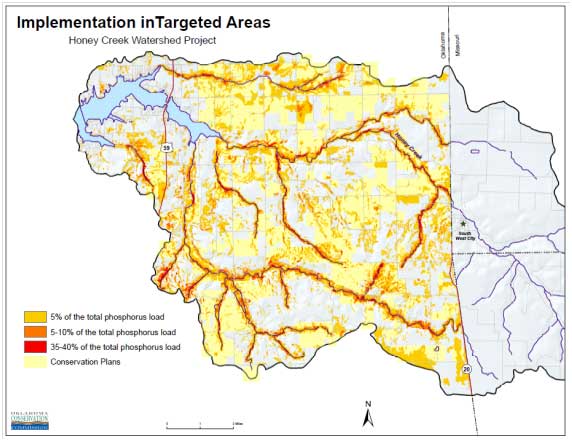Honey Creek Implementation Project Shows Water Quality Improving
Water Quality Success Stories
Recent monitoring data shows that implementation of best management practices (BMPs) by farmers and ranchers is resulting in improvement in water quality in a sub-watershed of Grand Lake, according to Shanon Phillips, director of the Oklahoma Conservation Commission’s (OCC) Water Quality Division.

In 2006 the Oklahoma Conservation Commission (OCC), in partnership with the U.S. Environmental Protection Agency (EPA) and the Delaware County Conservation District, and in cooperation with the USDA Natural Resources Conservation Service, began working with local landowners in the Oklahoma portion of the Honey Creek watershed, a sub-watershed of Grand Lake, on a project to improve water quality. The implementation project is funded primarily through EPA under Section 319 of the federal Clean Water Act, along with some state funding. The purpose of the project is to demonstrate the beneficial effects of BMPs in reducing the amount of “nonpoint source” pollutants (those carried in runoff) entering into streams that empty into Grand Lake. The pollutants specifically targeted in the project are phosphorus and bacteria. The program provides cost-share assistance to landowners in implementing those BMPs as well as education and demonstration of the BMPs promoted through the program on a demonstration farm in the watershed.
The BMPs are all aimed at reducing the amount of sediment and excess nutrients that enter into streams. The nutrients, namely phosphorus and nitrogen, may originate from sources such as fertilizers, animal wastes or sewage. It is the excess nutrients— more than existing plants can use — that runs off and causes algae growth and other problems in the streams. Bacteria that pose threats to human or animal health may also be present in runoff.
Among the BMPS is restoring or enhancing riparian (streamside) vegetation to help filter runoff water. Other practices include poultry litter storage, winter feeding facilities for livestock, pasture improvement, cross fencing, creation of ponds or other watering facilities, and transfer of poultry litter out of the watershed.
Approximately two thirds of the Honey Creek watershed lies in Oklahoma, with the remainder lying in Arkansas. Since the project began 86 Oklahoma landowners have enrolled, resulting in approximately 49 percent of the Oklahoma portion of the watershed having some kind of BMP in place. The implementation has occurred on approximately 42 percent of land identified as contributing high amounts of phosphorus in earlier watershed modeling.
“We are already seeing a nine to 15 percent reduction in phosphorus and a 40 percent reduction in E. coli and Enterococcus bacteria loading into the streams,” Phillips said. “And over time, the longer these practices are in place, we anticipate seeing the rate of reduction continue to climb,” she said.
Phillips referred to a similar project in the Beatty Creek watershed. In 2005, after five years of implementation and monitoring, a14 percent reduction in phosphorus was reported. More recent results show the reduction in phosphorus has climbed to 66 percent, with an 80 percent reduction in nitrogen loading into streams.
“In these projects we work with local landowners through voluntary, cooperative agreements,” Phillips said. “And in programs like this we have always run out of funding before we ran out of landowners wanting to participate,” she said. “The demonstration efforts show how effective BMPs can be in improving water quality and the cost-share assistance makes it economically feasible for landowners who really care about the land and water to participate,” she said.
Implementation of BMPs in the Honey Creek watershed is ongoing, with the project scheduled to end in February 2013. Monitoring data will be reanalyzed following that time to assess the further effects of the project on improving water quality.
